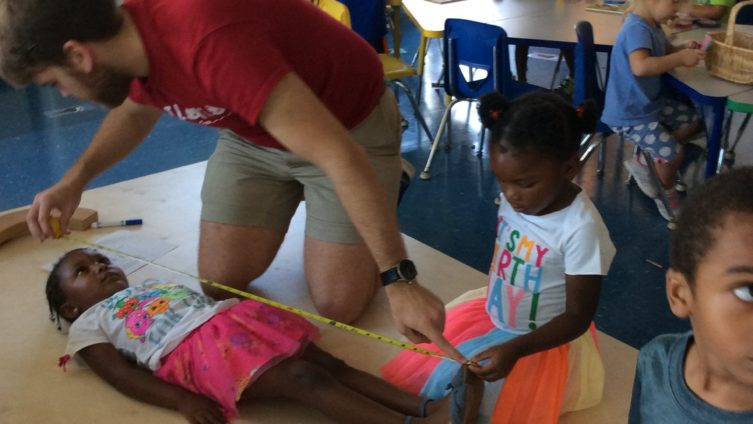
Our Early Learning program is led by highly-skilled specialists who work with our three-, four-, and five-year olds on developing a sharp skill set at an early age. Our program is play-based so our youngest students make sense of their world and articulate their experiences through play. In 2017, we began using the Reggio Emilia in our 3’s/4’s classrooms. Reggio Emilia is an academic approach that encourages inquiry, question, and curious learning in young students. Troy Byrne, who has taught early learners at TCS for two years, reviews year one of the approach in our 3’s/4’s classrooms and how it’s transforming brave learning at TCS.
Q: How would you describe the beginning of the year vs. end of year in 3’s/4’s?
A: The beginning of the year for 3’s/4’s is all about getting the kids used to the structure and the schedule of a normal school day. They are getting to know their new classroom, our materials, and their new friends! The end of the school year goes a lot more smoothly with the kids feeling more comfortable in their play space and taking their cooperative play (solving a problem by working together to achieve a common goal) to new levels. The goal of the whole year is to prepare the kids for the next year in 4’s/5’s.
Q: How has Reggio Emilia impacted the curriculum for 3’s/4’s? Was there a change from last year’s curriculum to this year’s?
A: We are so excited to have switched over to a Reggio Emilia approach to learning on the Early Learning team! The impact that the new approach has had on our class in particular is very stark. Last year, we had different units planned for each month, and we had several books and activities planned for those themes. It was very structured and purposeful. This year, with the Reggio Emilia approach, we have shared the decision-making with the kids and really involved them in the learning explorations that we have been embarking on. We no longer have units planned for each month, but rather take into consideration the children’s interests in different subjects that come up and let those interests (whatever they may be) guide our learning. It has really been a learning opportunity for both the students and the teachers, because we as teachers get to traverse the unknown with our students.
Q: What developmental/academic benefits have you seen in implementing Reggio Emilia?
A: There are definitely clear academic benefits to the Reggio Emilia approach, such as establishing curiosity and eagerness to learn at an early age. Our students come to The Children’s School with a desire to learn about a wealth of new ideas, and it is our job as teachers to nourish that curiosity. If we had stuck with our monthly units, we would be lucky if we sparked the interest of one or two students. With the Reggio approach, we are able to determine the interests of all of our students and explore what we can see they want to know more about. A lot of times, the teachers don’t know a lot about what we are teaching, so the students get to see us learning with them and enjoy obtaining new information. That can be inspiring to a young student and motivate them to inquire more about what they do not know. Knowing that their voices are being heard and their interests explored can really instill a sense of value in the children. If they see themselves as being in control of their own learning, then they are more likely to take risks and really question what they are learning. They take ownership of their education.
Q: Share some of your favorite memories from this year!
A: One of my favorite memories from this year has been our exploration of bees. Since our big playground is made up of mostly wood and is surrounded by flowers and trees, the kids really got interested in bees and what they do. We brought in a beekeeper to talk about how he takes care of bees and what makes up a beehive, and we even tasted different kinds of honey and took a class vote to determine which was our favorite flavor. We made a chart out of those votes and hung it up for the kids to look at for weeks after. They loved having a visual representation of the class vote and enjoyed showing it to those who came to visit our classroom! From that point on in the year, they really got into comparing numbers and representing them in different ways. Another way that represents how our children have grown is when we measure their height at the beginning of the year and compare it to how tall they’ve grown at the end of the year. They get to help measure their friends with a measuring tape and then their friend measures them. We also weigh them at the beginning and end of the year, and we show them how many more pounds they put on to show how big they’ve grown (because that matters a lot when you’re 3 or 4)!









